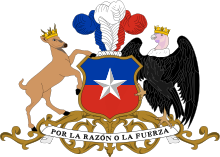National Anthem of Chile
| English: National Anthem of Chile | |
|---|---|
 |
|
|
National anthem of |
|
| Also known as | Canción Nacional English: National Song |
| Lyrics |
Eusebio Lillo, 20 September 1819 (1st adopted) |
| Music |
Ramón Carnicer, 20 August 1820 (1st adopted) |
| Adopted | 23 December 1828 |
| Music sample | |
|
|
|
Eusebio Lillo, 20 September 1819 (1st adopted)
Ramón Carnicer, 20 August 1820 (1st adopted)
The National Anthem of Chile (Spanish: Himno Nacional de Chile) is also known as Canción Nacional (National Song). It has a history of two lyrics and two melodies that made up three different versions. The current version was composed by Ramón Carnicer, with words by Eusebio Lillo, and has six parts plus the chorus.
The first Chilean National Anthem dates back to 1819, when the government called for, on the 19th of July, the creation of music and lyrics for this purpose.
The composer Manuel Robles and the poet Bernardo de Vera y Pintado fulfilled this mandate and their "National Song" debuted on 20 August 1820 in the Domingo Arteaga theater, although other historians claim that it was played and sung during the festivities of September 1819.
In the beginning, everyone would stand for the song. O'Higgins and Freire listened to it with respect and full of emotion, for they had marched to victory to its tune more than once.
The custom of always singing it at the theater slowly disappeared, until it was ordered that it only be sung at the anniversary of the country.
The doctor Bernardo Vera, known in the history of the independence, was the author of the verses that were sung to Robles' music.
This first hymn was sung until 1828, when it was replaced with what is sung today.
The second Chilean National Anthem was composed by the Spanish composer Ramón Carnicer, when he was exiled in England because of his liberal ideas. Mariano Egaña, Chilean Minister in London, acting on the criticism that Robles' song was receiving, asked Carnicer to compose a new hymn with Bernardo de Vera's original text.
The Spanish musician probably wrote the work by 1827, the date he returned to Barcelona, and his hymn debuted in Santiago, in the Arteaga theater, 23 December 1828.
Years later, in 1847, the Chilean government entrusted the young poet Eusebio Lillo with a new text that would replace the anti-Spain poem of Vera y Pintado, and after being analyzed by Andrés Bello, retained the original chorus ("Dulce patria, recibe los votos..."). The lyrics were slightly revised in 1909.
During the military government (1973–1990) of Augusto Pinochet, the Verse III was officially incorporated because of his praise of the armed forces and the national police (Carabiners). After the end of Pinochet's regime, in 1990, it was only sung in military events. Supporters from the former military regime also sing the anthem with the Verse III in private ceremonies and rallies.
...
Wikipedia
